Photographs: Courtesy, Honda Sharmistha Mukherjee & Surajeet Das Gupta
Unlike many business heads, Hironori Kanayama is surprisingly optimistic about the latent potential of the Indian market and predicts that a turnaround is imminent.
When Hironori Kanayama was appointed President of Honda Automobile (China) Company in late 2003, he was told to grow sales four-fold to 40,000 units over four years.
He achieved the target in two and went on to triple sales to 120,000 units by 2007. So, when the Japanese auto major decided to realign its operations in India in April 2012, it was almost inevitable that Kanayama would be assigned to head the company.
His challenges were not small. He would have to steer the subsidiary through a broken joint-venture in an industry in which the company had limited presence owing to a lack of mass-market models and consumers were shifting to diesel cars driven by the government's fuel pricing policy, write Sharmistha Mukherjee and Surajeet Das Gupta.
...
The man behind Honda's success in India
Photographs: Courtesy, Honda
Japanese CEOs in India tend to have minimal contact with journalists, partly on account of a language gap (many are not fluent in English) but also because the rambunctious nature of the country's media disconcerts them.
But to our surprise, Kanayama agreed to our tentative invitation and even offered an inspiring choice for lunch: San Gimignano, the peerless if somewhat high-priced Italian restaurant at The Imperial in central Delhi.
Kanayama arrives, fortified by his corporate communication team and a good eye for the pick of the San G menu. He chooses minestrone, the spicy Italian vegetable soup for which San G is famous, to start, and lobster linguine as the main course, and we follow suit.
...
The man behind Honda's success in India
Image: Hironori Kanayama.Photographs: Courtesy, Honda
We marvel that he is able to take time out for this lunch since he has clearly not been idle since he took charge after Honda's less-than-amicable break-up with the Shriram Group after the Japanese major bought out the Indian partner in August 2012.
Honda's new-found single status has clearly helped. With small car Brio in its fold, Honda outgrew European car maker Volkswagen to sell 73,483 units in the last financial year.
The company recently launched its first diesel model, the Amaze, in the Indian market.
Production is full steam ahead at the facility in Greater Noida, Uttar Pradesh and Rs 2,500 crore (Rs 25 billion) is being invested in a diesel engine unit, a second car assembly line for 120,000 units and a forging plant in Tapukara, Rajasthan.
Till September this fiscal, Honda's sales grew 68 per cent to 59,617 units - at a time when the domestic automobile market shrank five per cent.
The man behind Honda's success in India
Image: Hironori Kanayama at the launch of Honda Amaze.Photographs: Courtesy, Honda
Unlike many business heads , Kanayama is surprisingly optimistic about the latent potential of the Indian market and predicts that a turnaround is imminent.
"We are working to the maximum extent and, of course, we hope for recovery at the earliest. The rupee has picked up. I hope the Indian economy will pick up as we have a new RBI governor," he says thoughtfully.
Since Kanayama has spent nearly a third of his career bolstering sales for Honda in China, the conversation turns to the differences in market dynamics between the two countries. as we dig into a satisfyingly spiced minestrone.
He attributes the phenomenal growth in China to the policies the government put in place to attract foreign investment as far back as 1980. Which is why, he says, "manufacturers from Honda to Nissan and Toyota put in their money - and eventually in 2002-03 the market exploded."
...
The man behind Honda's success in India
Photographs: Courtesy, Honda
With Chinese purchasing power increasing at the same time, the two markets diverged. In India, the mid-size City has been Honda's flagship model; in China consumers prefer SUVs and premium sedans like CR-V and Accord.
"Their per capita income is about $6,000, which makes a difference. In comparison with other south-east Asian countries, car prices here are 30 to 50 per cent lower."
But what made Honda wait so long before striking out in the Indian market, we ask. Kanayama laughs. He gets the same question from his associates, he tells us.
"It's only in India and in Europe that we see diesel demand. America, Japan, China and Latin America have only 1 to 2 per cent sales in diesel, so, we prioritised those advanced markets."
...
The man behind Honda's success in India
Photographs: Courtesy, Honda
Also, he points out, although the decision to enter the diesel car market was made much earlier, it takes time to develop a brand new engine. "Honda takes pride in making its own engines," he is at pains to point out.
The linguini with lobster chunks arrives and as we duck into the thick pasta, rich with cream and cheese, we try to provoke him. Where does he see Honda among established players such as Maruti Suzuki and Hyundai?
Kanayama skirts the question cleverly. "Our target is always our customer, products must be competitive and being competitive means ensuring the customer likes our cars."
And what did he make of the frequent labour disputes that plagued so many auto manufacturers including Honda's two-wheeler arm? This is a subject on which Kanayama has some experience.
...
The man behind Honda's success in India
Photographs: Courtesy, Honda
As a union officer in Honda, Kanayama travelled around the conglomerate's global network in 25 countries interacting with workers for over six years. So, he is in a strong position to phlegmatically suggest that these outbreaks were very natural.
"As the economy grows people ask for increments, then they go on strike. But when you stop production it means we lose customers. So, when there is a labour dispute, I tell them, 'You don't have to work for me, but work for those people who are dependent on operations - engineers, suppliers, dealers, bankers and so on'."
As a union officer in Honda, he frankly admits, "I was not happy with the management, so, I joined thinking I will change them, and union activity taught me a lot. One thing I learnt was that my counterpart in management was often older than I, and where I, as a union officer, had a commitment to the workers, the management may choose not to follow me. So, the real challenge was how to make the management listen to me."
Click NEXT to reads more...
The man behind Honda's success in India
Photographs: Courtesy, Honda
As we sift through the menu for dessert, Kanayama says communicating with associates has helped him to understand operations better and delegate responsibility.
"Of course, I have to oversee some critical points, but I leave the authority to the vice-presidents and general managers, because if I interfere they will ask my opinion on every aspect, which is very wrong and makes our operations very inefficient. Besides, human enthusiasm is a very important management resource. Human beings make a difference. Therefore, the development of human resources is very important in any organisation. A company can be competitive only if the associates are competitive."
Kanayama does not travel much within India but does take out the time to play for employees on the company's foundation day in December every year. He is enthusiastic about the guitar and strums English and Japanese songs.
...
The man behind Honda's success in India
Photographs: Courtesy, Honda
"I try to learn Indian music," he says as he sips a post-prandial coffee. We dig into our creme brulee, delectably caramelised.
We venture a question on Honda's failed joint ventures in the country. Is it the company's philosophy to walk alone? Kanayama clarifies that he has amicable relations with Honda's former partners and even dines with them occasionally. "It is not part of the Honda policy.
Even in the motorcycle case (where Honda parted ways with the Hero group), Honda has never requested a break-up.
When we thought of investment, our partners said please do it by yourselves. In China, we have 50 per cent joint ventures in different parts of the automobile industry but we get along very well with them," he says.

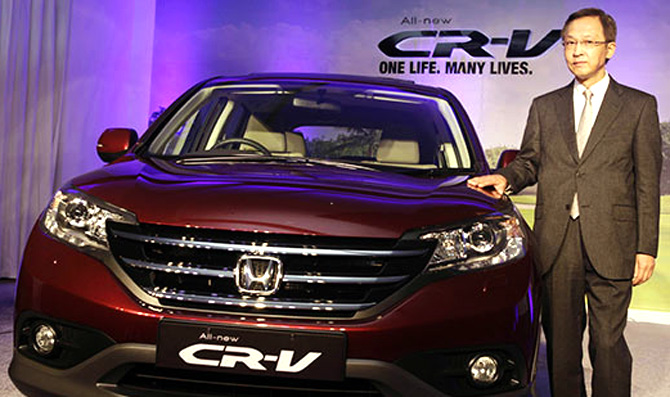
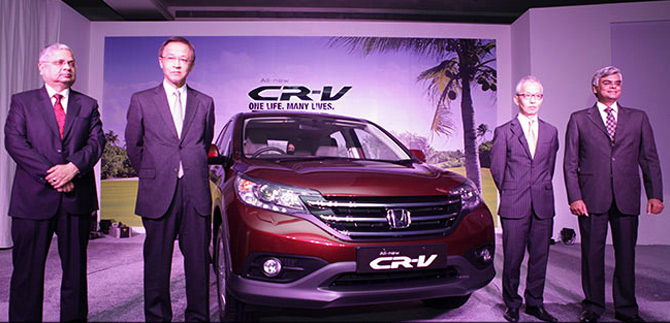
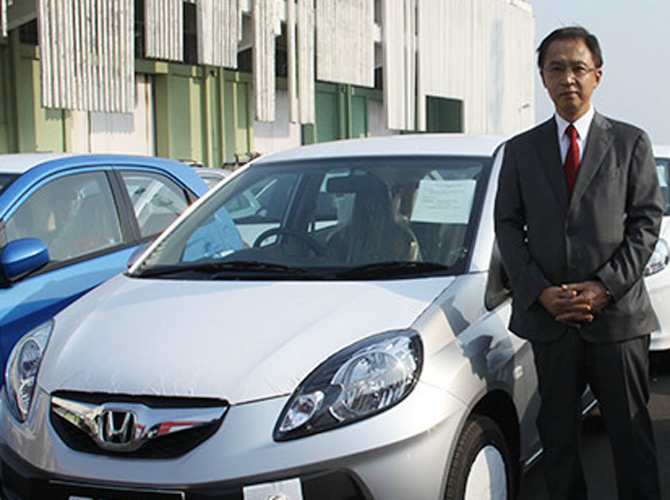
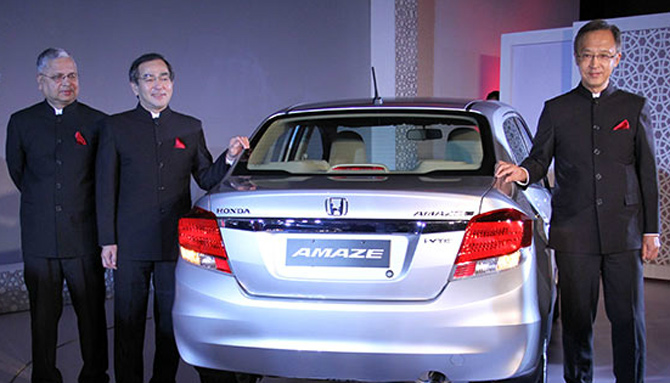
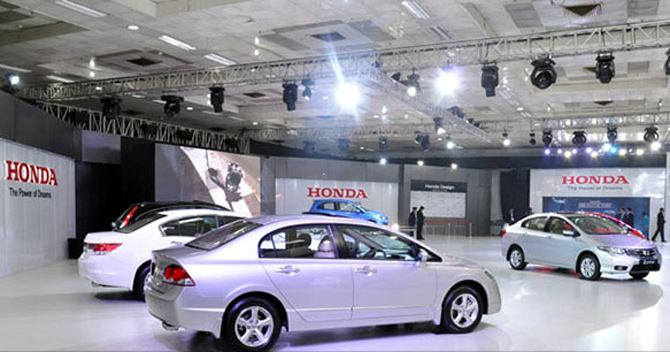


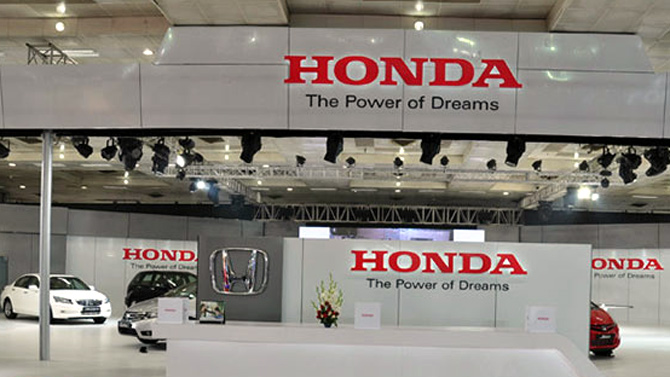
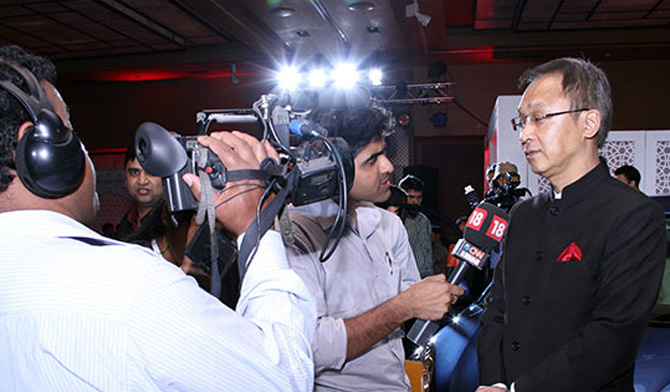

article